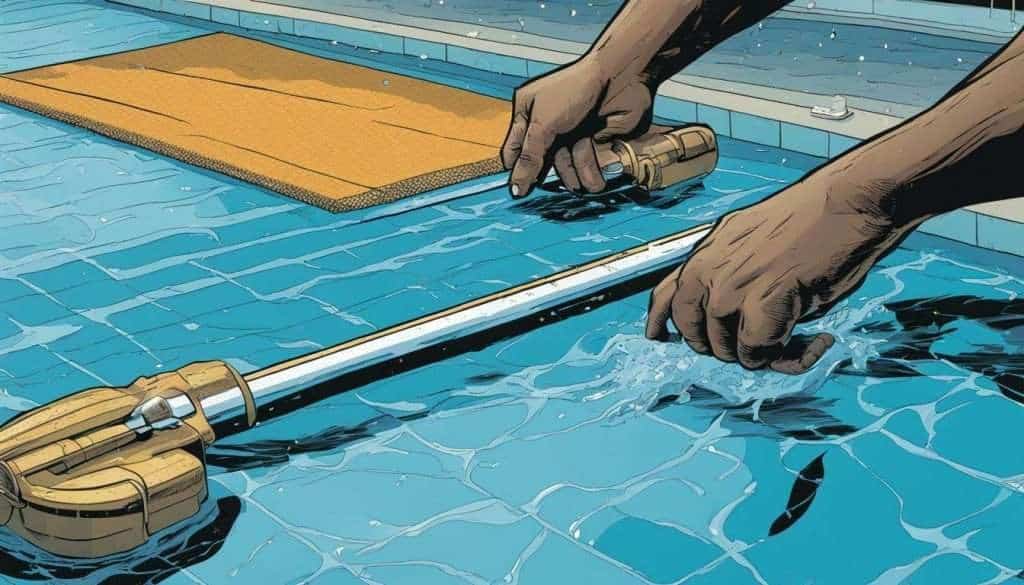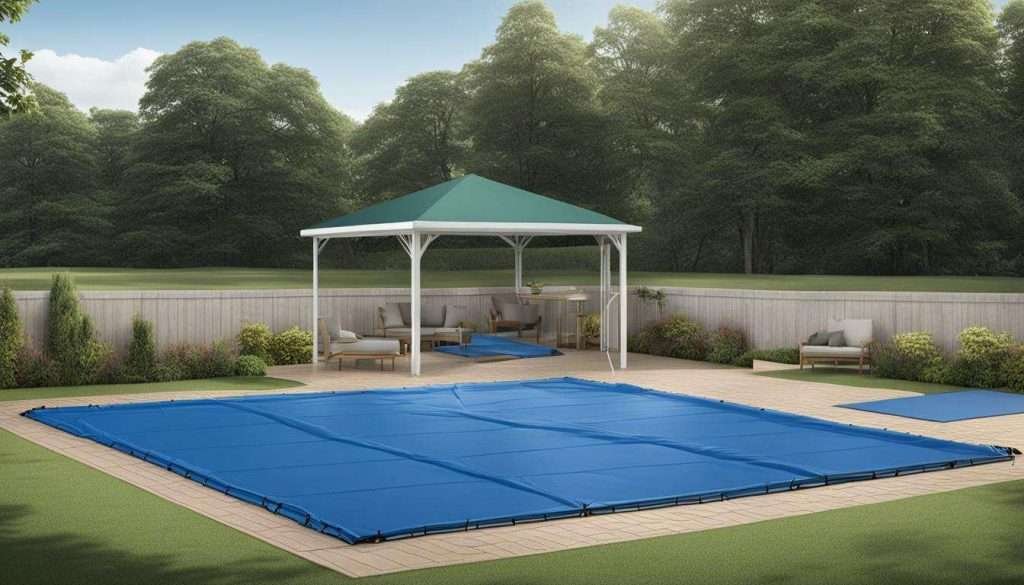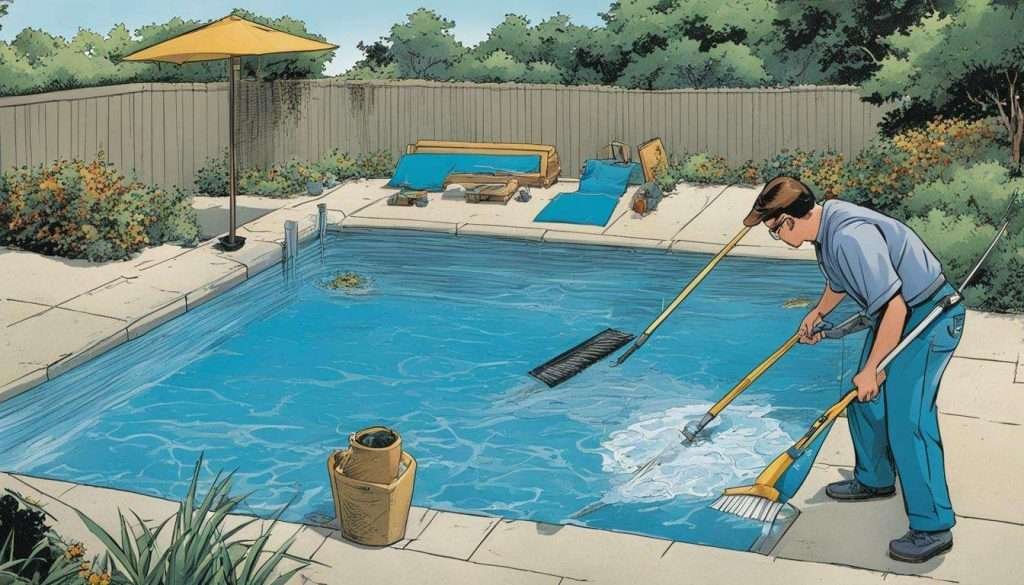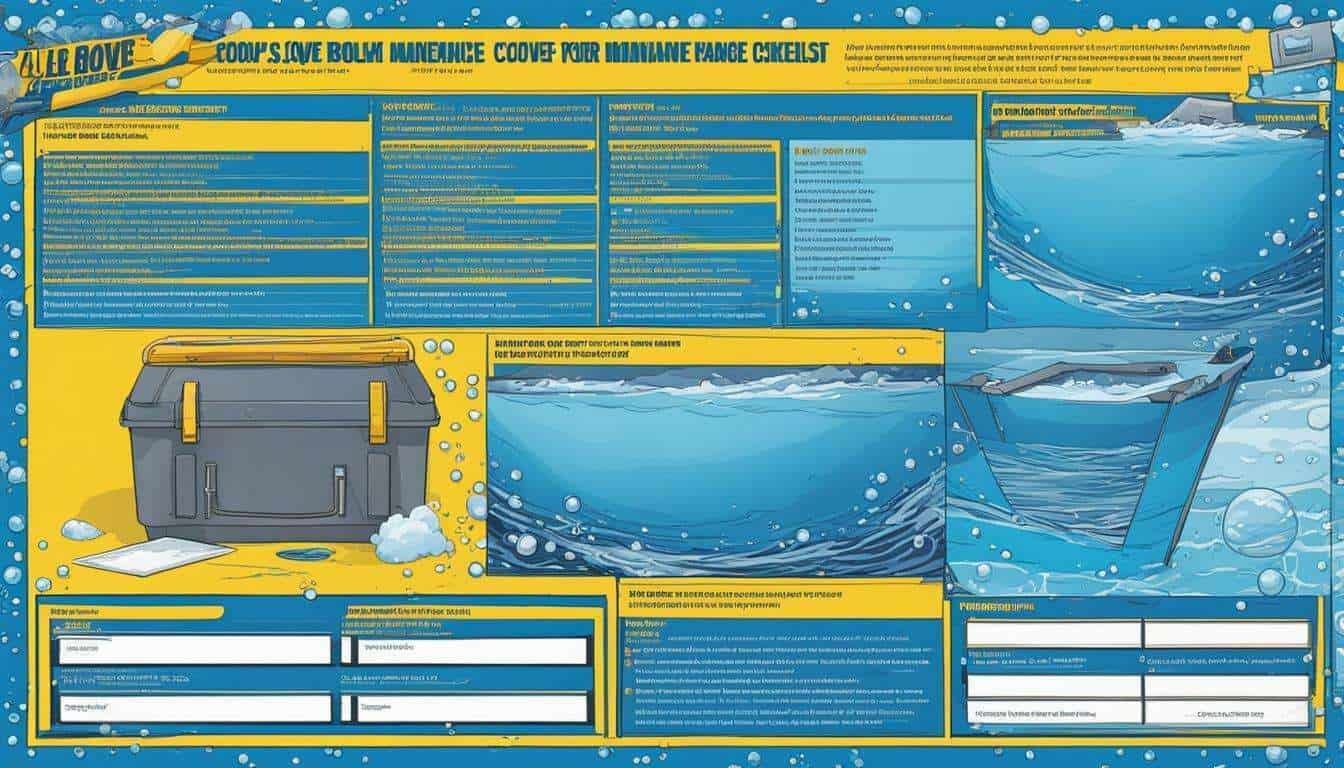Welcome to our complete pool cover maintenance checklist, where we share our expert guidance on ensuring the longevity and cleanliness of your pool covers. Proper maintenance is crucial for the safety and protection of your swimming pool, as well as for maximizing its lifespan. In this comprehensive guide, we will cover everything from understanding different types of pool covers to seasonal considerations and pool cover safety measures. By following our checklist and implementing these best practices, you can maintain a pristine pool and enjoy its benefits for years to come.
Key Takeaways:
- Regular pool cover maintenance is essential for the safety, cleanliness, and longevity of your swimming pool.
- There are various types of pool covers, each with unique features and maintenance requirements.
- Proper installation, removal, and regular maintenance of pool covers are crucial for optimal performance.
- Seasonal considerations, such as winter preparation and pool opening in spring, are important for maintaining your pool covers.
- Implementing pool cover safety measures is essential to protect your family and pets.
Understanding Different Types of Pool Covers and Their Maintenance Requirements
To effectively maintain your pool covers, it’s important to understand the different types available and their specific maintenance needs. Let’s explore the various types of pool covers: Some covers are designed to provide warmth and reduce evaporation, while others focus on safety and debris protection. When choosing the best pool covers for homes, consider factors such as pool size, local climate, and the intended purpose of the cover. Proper care will ensure their longevity and effectiveness in keeping your pool clean and safe. Different types of pool covers include safety covers, solar covers, and winter covers, each designed for unique purposes and requiring distinct care routines. For those considering a purchase, researching buying a pool cover tips can greatly enhance your decision-making process. Understanding how these covers function will ensure your pool remains clean and safe throughout the seasons.
Safety Covers
Safety covers are designed to secure your pool and provide added protection, especially for families with children or pets. Made from durable materials, they can withstand heavy loads and prevent accidental falls into the pool.
Maintenance: Safety covers should be regularly inspected for any damage, such as tears or loose straps. Clean the cover using a mild detergent and water, and remove any debris or leaves that may accumulate on its surface.
Solar Covers
Solar covers help to heat your pool by harnessing solar energy. They act as a passive solar heater, trapping and transferring heat to the pool water while also preventing water evaporation.
Maintenance: Keep the solar cover clean by periodically scrubbing it with a soft brush and a mild soap solution. Avoid using abrasive cleaners or strong chemicals that could damage the cover’s material.
Winter Covers
Winter covers are specifically designed to protect your pool during the off-season. They provide a barrier against debris, leaves, and harsh weather conditions, keeping your pool clean and minimizing maintenance when it’s not in use.
Maintenance: Remove any debris, leaves, or standing water from the winter cover periodically. Inspect the cover for any signs of wear and tear, and repair or replace it if necessary.
Automatic Covers
Automatic covers offer convenience and efficiency, allowing you to open and close your pool with the touch of a button. These covers provide safety, insulation, and protection against debris.
Maintenance: Regularly clean the cover and its tracks to prevent debris buildup. Inspect the cover’s mechanisms to ensure smooth operation, and address any issues promptly by contacting a professional technician.
Mesh Covers
Mesh covers are designed to allow water to pass through while blocking out debris. They are an excellent option for pool owners who want to maintain water cleanliness while minimizing maintenance.
Maintenance: Periodically clean the mesh cover using a soft brush and a mild detergent. Remove any leaves or debris that may accumulate on the cover’s surface. Inspect and repair any tears or loose straps.
Understanding the different types of pool covers and their maintenance requirements is essential for ensuring the longevity and effectiveness of your pool cover. Regular cleaning, inspection, and proper storage will help you maximize the lifespan of your cover and maintain a clean and safe swimming pool environment.
Proper Installation, Removal, and Regular Maintenance of Pool Covers
To maximize the effectiveness of your pool covers, it’s vital to ensure they are installed correctly, removed properly, and regularly maintained. Proper installation guarantees that the covers fit securely, providing optimal protection for your pool. When installing, follow the manufacturer’s instructions carefully, ensuring that the covers are aligned and anchored correctly. This will prevent debris from entering the pool and ensure the covers stay in place, even during inclement weather.
When the swimming season draws to a close, the removal process needs to be done with care. Gently remove the covers, ensuring that no debris falls into the pool. Clean and dry the covers thoroughly before storing them in a cool, dry place. Additionally, inspect the covers for any signs of damage or wear and tear that may require repairs or replacement.
Regular maintenance is essential to keep your pool covers in optimal condition. Clean the covers periodically to remove dirt, leaves, and other debris. Use a soft brush or hose to gently scrub the covers, avoiding harsh chemicals or abrasive tools that may damage the material. Inspect the covers for any signs of damage, such as tears or holes, and repair them promptly to prevent further deterioration. Regularly checking the covers will help identify potential issues early on, ensuring your pool remains protected throughout the year. Additionally, consider investing in a storage bag or container when the covers are not in use to keep them secure and protected from the elements. Following these tips for pool cover maintenance will prolong the life of your covers and enhance their performance. Always consult the manufacturer’s guidelines for specific care instructions tailored to your cover’s material.
| Installation | Removal | Regular Maintenance |
|---|---|---|
| Follow manufacturer’s instructions | Remove carefully to prevent debris from entering the pool | Clean periodically to remove dirt and debris |
| Ensure proper alignment and anchoring | Clean and dry covers before storage | Inspect for damage or wear and tear |
| Check for signs of damage or repairs | Repair any tears or holes promptly |

Remember, improper installation, removal, or neglecting regular maintenance can significantly reduce the lifespan and effectiveness of your pool covers. Taking the time to follow these steps will ensure that your pool remains protected and that you can enjoy a clean and safe swimming experience for years to come.
Seasonal Considerations for Pool Cover Maintenance
As the seasons change, specific pool cover maintenance tasks become necessary. In this section, we will guide you through the seasonal considerations for maintaining your pool covers.
Winter preparation is a crucial aspect of pool cover maintenance. Properly winterizing your pool cover ensures protection against harsh weather conditions and prevents damage. Before winter sets in, remove any debris, leaves, or twigs from the pool cover using a pool cover pump or skimmer. It is also important to check for any signs of wear or tear and repair them promptly to avoid further deterioration.
| Maintenance Tasks | Actions |
|---|---|
| Snow and Ice Management | Regularly remove snow from the pool cover using a soft broom or leaf blower. Avoid using sharp tools that may damage the cover. When it comes to ice, avoid breaking it manually or using hot water as this can cause damage. Instead, allow it to melt naturally. |
| Pool Opening in Spring | As spring approaches, it’s time to remove the pool cover and prepare for the swimming season. Clean the cover thoroughly before storing it away, ensuring it is completely dry to prevent mold growth. Inspect the cover for any damages and repair or replace it if necessary. Take this opportunity to also inspect the pool itself, checking for any maintenance or cleaning requirements. |
“Proper winterization and regular snow and ice management are essential for protecting your pool cover and ensuring its longevity.”
By following these seasonal considerations, you can enhance the lifespan of your pool cover and maintain its optimal performance. Additionally, these steps contribute to the overall safety and cleanliness of your swimming pool, providing a pleasant swimming experience for you and your family.

As the seasons change, it’s important to adapt your pool cover maintenance routine. By addressing winter preparation tasks, managing snow and ice effectively, and properly opening the pool in spring, you can ensure the longevity and functionality of your pool cover. Remember to follow the manufacturer’s guidelines and consult a professional if you need assistance with complex maintenance procedures.
Key Takeaways:
- Winterize your pool cover to protect against harsh weather conditions.
- Regularly remove snow from the cover and avoid breaking ice manually.
- Thoroughly clean and inspect the cover before storing it for the season.
- Utilize professional assistance for complex maintenance tasks.
By incorporating these seasonal considerations into your pool cover maintenance routine, you can ensure the safety, cleanliness, and longevity of your pool and enjoy many refreshing swims for years to come.
Pool Cover Safety Measures and Best Practices
Safety should always be a top priority when it comes to pool cover maintenance. In this section, we will discuss essential safety measures and best practices to protect your loved ones.
1. Always secure the pool cover properly: A loose or improperly secured pool cover can pose a safety hazard, especially if you have children or pets. Make sure the cover is tightly fastened and that all straps and anchors are in good condition.
2. Regularly inspect the pool cover for damage or wear: Over time, pool covers can develop tears, fraying, or other forms of damage that compromise their effectiveness. Inspect the cover regularly and promptly repair any issues to ensure maximum safety.
3. Implement pool barrier measures: In addition to using a pool cover, it’s important to have other safety measures in place. Installing a pool fence, safety gate, or alarm system can provide an additional layer of protection, especially when young children are around.

4. Educate family members and visitors about pool cover safety: Ensure that everyone who uses or visits your pool understands the importance of pool cover safety. Teach them how to properly handle the cover, avoid walking or jumping on it, and be cautious when removing or replacing it.
5. Regularly test and maintain pool cover hardware: The hardware components of your pool cover, such as springs, anchors, and straps, should be regularly inspected and maintained. Replace any damaged or worn-out parts to ensure the cover functions properly.
Summary
Implementing pool cover safety measures and best practices is crucial for maintaining a safe swimming environment. From securing the cover properly to regular inspections and educational efforts, every step taken towards pool cover safety significantly reduces the risk of accidents. By prioritizing safety, you can enjoy your pool with peace of mind, knowing that your loved ones are protected. Additionally, implementing pool cover safety measures can enhance the longevity of your pool cover and reduce maintenance costs. It’s important to involve the entire family in safety discussions, fostering a culture of awareness and responsibility around the pool area. Regular training sessions on how to properly use the cover can further ensure everyone’s safety while enjoying the water.
| Safety Measures | Best Practices |
|---|---|
| Secure the pool cover properly | Regularly inspect the pool cover for damage or wear |
| Implement pool barrier measures | Educate family members and visitors about pool cover safety |
| Regularly test and maintain pool cover hardware |
Implementing a Comprehensive Pool Cover Maintenance Checklist
To ensure efficient and organized pool cover maintenance, it is essential to follow a comprehensive checklist. In this section, we will walk you through the necessary steps to keep your pool covers in excellent condition.
First and foremost, start by regularly skimming off debris from the pool cover’s surface. Leaves, twigs, and other debris can accumulate and weigh down the cover, leading to potential damage. Use a pool skimmer or a leaf net to remove any debris before it settles on the cover.
Next, maintaining proper water chemistry is crucial to prevent the buildup of algae, bacteria, and other contaminants. Regularly test your pool’s water and ensure that it is properly balanced. This includes monitoring pH levels, alkalinity, and sanitizer levels. By keeping the water chemistry in check, you can prevent staining, cloudiness, and damage to your pool cover.
Cleaning the filter is another important task to include in your maintenance checklist. A dirty or clogged filter can hamper the efficiency of your pool’s circulation system and contribute to water quality issues. Follow the manufacturer’s instructions for cleaning and maintaining your specific filter type, whether it’s a sand, cartridge, or diatomaceous earth filter.
Inspecting your pool equipment is also essential for effective pool cover maintenance. Regularly check for any signs of wear or damage to the pool cover reel, straps, and hardware. Additionally, inspect the pool cover itself for tears, rips, or loose stitching. Taking prompt action to repair or replace any damaged components will help extend the lifespan of your pool cover.
| Task | Frequency |
|---|---|
| Skimming off debris | Weekly |
| Balancing water chemistry | Every 1-2 weeks |
| Cleaning the filter | Monthly |
| Inspecting pool equipment | Every 3 months |
Lastly, don’t forget to manage the water level and maintain the area surrounding your pool. Ensure that the water level is neither too high nor too low, as excessive water can put strain on the cover, while low water levels can expose the pool walls and equipment. Additionally, regularly clean the pool surroundings to prevent debris from finding its way into the pool when the cover is off.
By following a comprehensive pool cover maintenance checklist, you can ensure that your pool covers are well-maintained and ready for use. Remember to adapt the frequency of tasks to your specific pool and climate conditions. With regular care and attention, your pool covers will not only last longer but also provide a safe and clean swimming experience for you and your family.

Regular maintenance of your pool covers is crucial for maintaining a safe, clean, and long-lasting pool. By following our expert guide and utilizing a comprehensive checklist, you can ensure that your pool covers remain in optimal condition year-round.
Proper installation, removal, and regular maintenance are essential for all types of pool covers, including safety covers, solar covers, winter covers, automatic covers, and mesh covers. Each type has unique features and maintenance requirements that need to be addressed to prolong their lifespan and effectiveness.
Hiring a professional pool cover maintenance company can provide expertise and ensure that the installation and maintenance are done correctly. This not only saves valuable time and energy but also ensures compliance with warranty terms and conditions.
Seasonal considerations such as preparing your pool covers for winter, managing snow and ice, and opening the pool in spring are important to prevent damage and maintain the integrity of the pool covers.
Implementing pool cover safety measures is crucial to protect your family and pets. These measures include securely fastening the covers, installing pool alarms, and using safety accessories like locks and anchors.
By following a comprehensive pool cover maintenance checklist, you can efficiently and systematically complete important tasks such as skimming off debris, balancing water chemistry, cleaning the filter, inspecting pool equipment, managing water levels, and maintaining the pool surroundings. This ensures that all aspects of your pool covers and pool area are well-maintained and contribute to the overall cleanliness and longevity of your pool.
Streamlining pool maintenance processes can be achieved by using a low-code platform like DATAMYTE. This allows businesses to manage and track their pool maintenance activities effectively, ensuring consistent care and efficient upkeep of pool covers.
What Should I Include in my Pool Cover Maintenance Checklist?
When it comes to pool cover maintenance, a thorough checklist ensures lasting protection. Firstly, inspect for any damages or tears and patch them up if needed. Clean the cover regularly to remove debris and prevent algae growth. Keep an eye on the water level and drain any excess. Lastly, ensure the pool cover is properly secured. For a comprehensive guide on choosing and maintaining the best pool covers, refer to the “best pool covers guide.
FAQ
Q: Why is maintaining pool covers important?
A: Maintaining pool covers is essential for the safety, cleanliness, and longevity of swimming pools.
Q: What are the different types of pool covers?
A: The different types of pool covers include safety covers, solar covers, winter covers, automatic covers, and mesh covers.
Q: What are the maintenance requirements for different types of pool covers?
A: Each type of pool cover has unique features and maintenance requirements that should be followed for optimal performance.
Q: Why is proper installation and removal of pool covers important?
A: Proper installation and removal of pool covers are crucial for their effectiveness and to prevent damage to the cover and pool.
Q: What are the benefits of hiring a professional pool cover maintenance company?
A: Hiring a professional pool cover maintenance company offers expertise, time and energy savings, and ensures warranty compliance.
Q: What are the seasonal considerations for pool cover maintenance?
A: Seasonal considerations include preparing for winter, managing snow and ice, and opening the pool in spring.
Q: How can pool cover safety measures be implemented?
A: Implementing pool cover safety measures is important to protect family and pets. Guidelines and best practices should be followed.
Q: How can a comprehensive pool cover maintenance checklist be implemented?
A: Implementing a comprehensive pool cover maintenance checklist allows for efficient and organized maintenance, ensuring tasks are completed in a systematic manner. One of the most important aspects of pool cover maintenance is regularly checking for tears, holes, and other damage, which can compromise the cover’s effectiveness. Another crucial task on the maintenance checklist is cleaning the cover to prevent the buildup of debris and algae. For automatic pool covers, it is also important to periodically check the motor and ensure it is functioning properly to guarantee smooth operation.


